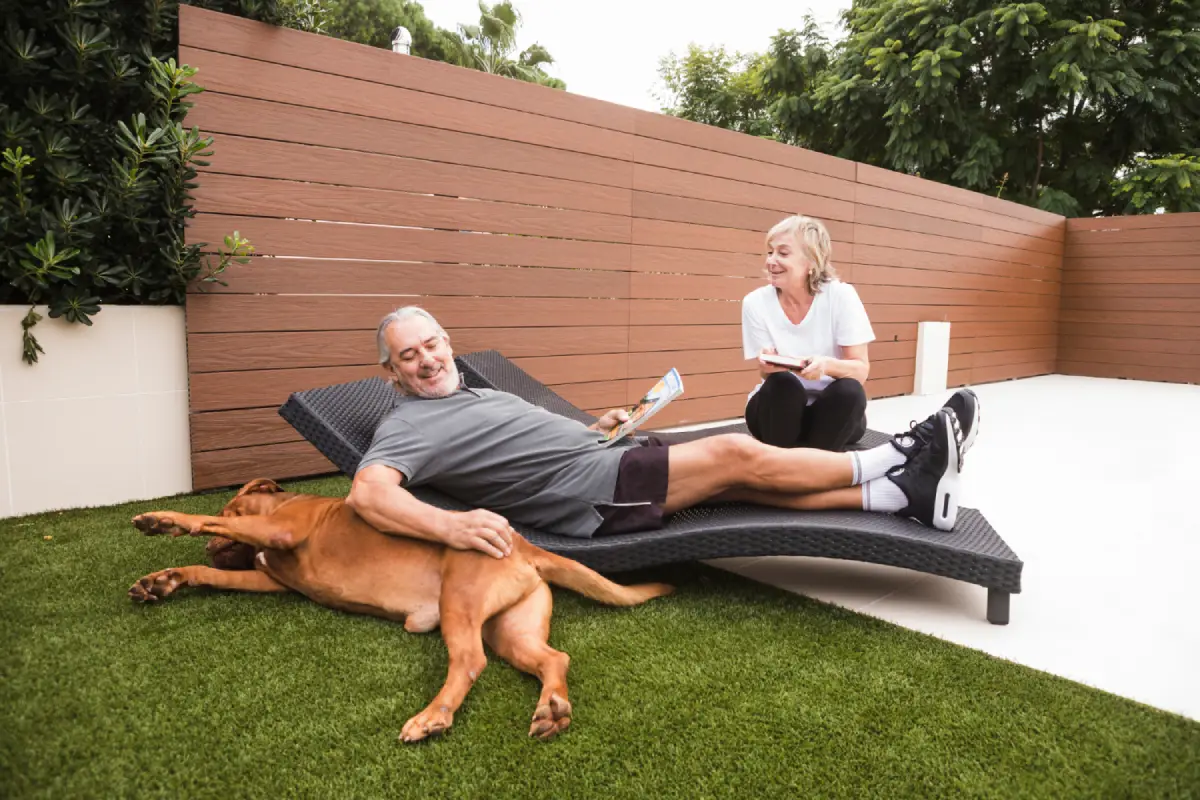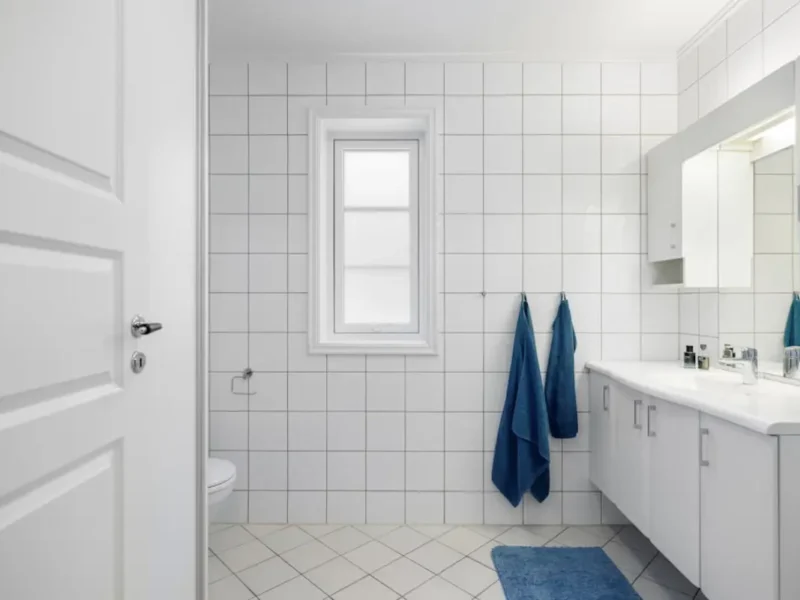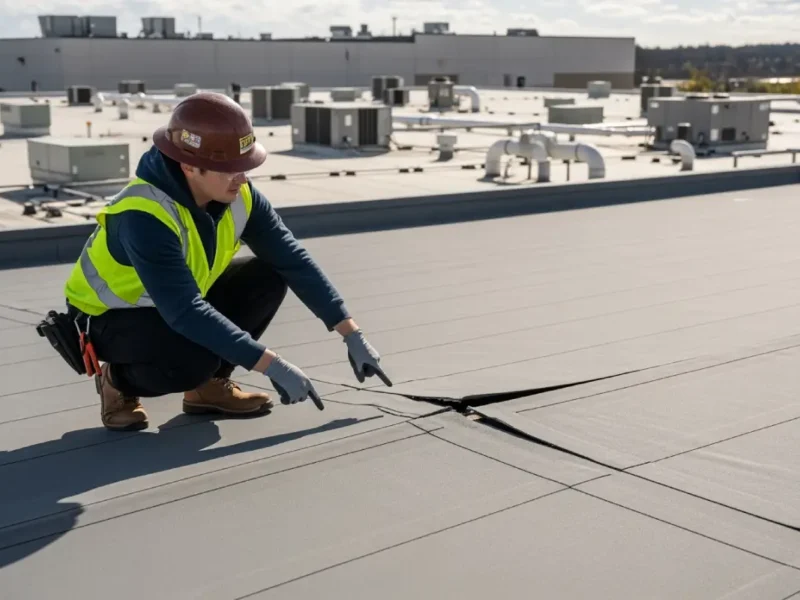Artificial grass has gained immense popularity among pet owners in recent years, as it provides the look and feel of a lush natural lawn without the constant upkeep that comes with real turf. Not only does a synthetic lawn stand up admirably to the wear and tear of energetic pups, but it also remains vibrantly green through rain, heat, or heavy foot traffic.
Dog owners appreciate that artificial turf is durable and comfortable, allowing their canine companions to run and play without tearing up the ground or returning inside caked in mud. However, having a dog-friendly yard requires attention to certain pet-specific details beyond the general low-maintenance promise of artificial turf. Consistent care is especially important to avoid problems such as lingering odors, unsightly stains, matting, or harmful pathogens resulting from frequent dog use.
You can create a safe, fresh, and inviting home landscape for your furry friends with a few best practices and helpful products. Discover how smart choices—such as installing dog-friendly artificial grass Boca Raton—can transform your pet maintenance routines and enhance the enjoyment of your yard for years to come.
Whether you’re caring for a boisterous puppy discovering the great outdoors for the first time or a laid-back older dog who loves to sunbathe in the afternoon, your approach to turf maintenance directly impacts their safety and comfort. Dogs spend much time with their noses and paws close to the ground, minimizing their exposure to waste, bacteria, or potentially harmful chemicals that could accumulate on artificial grass if improperly maintained.
Contents
Prompt Removal of Solid Waste
The foundation of a clean artificial lawn is prompt waste removal. When pet waste is left unattended, even for a day or two, it quickly becomes a breeding ground for bacteria, creating a dirty appearance that mars your lawn’s aesthetics.
Not only does this impact the overall look and long-term durability of your synthetic turf, but it can also create unpleasant odors that linger and attract insects. By making it a habit to scoop up after your dog at least once a day using a pooper scooper, shovel, or disposable bags, you reduce the chance of unpleasant smells and help maintain outdoor hygiene for your entire household.
When dealing with stubborn remnants or residue that remain after picking up waste, rinsing the affected area with a gentle stream from your garden hose makes it easy to restore cleanliness. Tending to waste promptly is a small task that yields major rewards in terms of hygiene, turf longevity, and pet safety, making your backyard a more inviting space for everyone.
Regular Rinsing of Urine Spots
Dogs typically gravitate to a favorite spot when urinating, which can soon result in patches of unpleasant, lingering odors if left untreated. Unlike natural grass, where rainwater and soil microbes help break down urine naturally, synthetic turf requires extra attention to stay fresh. The turf fibers and the underlying surface may trap bacteria and ammonia, creating a persistent smell if those areas aren’t dealt with frequently.
Prevent problems by rinsing the spots where your pet urinates most often—ideally after each use, or at least every couple of days. This simple step, using a regular garden hose or even a watering can, helps to dilute and flush away urine, minimizing the risk of bacterial buildup and keeping unpleasant odors at bay.
Turf specifically designed for pet use, such as dog-friendly artificial grass Boca Raton, often incorporates advanced drainage systems, which makes rinsing fast and virtually effortless. This approach protects your turf investment and ensures everyone can enjoy the yard without the nuisance of lingering smells or potential health risks.
Use of Pet-Safe Cleaning Solutions
Even with regular rinsing and daily cleaning, some high-traffic areas or favorite lounging spots can still accumulate organic material and persistent odors. In these cases, a deeper clean using specialized products becomes necessary. Enzyme-based cleaning solutions are ideal because they break down and neutralize organic materials at the source, rather than merely masking the odor with fragrances.
These cleaners are specially formulated to be non-toxic and safe for pets, meaning your dog can roll or play on the lawn immediately after application without risk of skin irritation or adverse health effects. When selecting a turf cleaner, always confirm that it’s recommended for use around animals—this guarantees no lingering residues that could irritate sensitive paws, noses, or skin.
Consistent use of enzyme cleaners can make a measurable difference in maintaining the overall freshness of your yard and safeguarding the well-being of your lawn and your furry companions. Enzyme cleaners can also be used throughout the year to tackle seasonal bacteria and keep surfaces free of allergens.
Avoidance of Harsh Chemicals
It might be tempting to use strong chemical agents or household disinfectants such as bleach or ammonia to kill stubborn odors and bacteria on your artificial lawn. However, these chemicals can do more harm than good over time. Not only can they break down the fibers and color of your artificial turf, reducing its lifespan and diminishing its appearance, but they’re also potentially harmful to pets who spend time outside. Chemical exposure can lead to skin irritation, allergic reactions, or even gastrointestinal issues and respiratory distress in some dogs.
Instead, always opt for mild, animal-safe cleaning products or natural alternatives that get the job done without introducing unnecessary hazards. This approach will preserve the integrity and longevity of your artificial turf, allowing it to withstand years of pet use while protecting your dog’s health and well-being throughout the year.
Regular Brushing to Maintain Turf Appearance
Artificial grass is built to endure the heavy paw traffic of even the most enthusiastic dogs, but over time it can start looking flat or matted, especially in areas where your pet frequently runs, plays, or lies down. To keep your turf looking lush and upright, use a stiff-bristled brush or a synthetic turf rake to gently comb the blades in the opposite direction of their natural lay. This helps restore your artificial grass’s appealing, soft look while redistributing the infill evenly throughout the turf’s foundation.
Aim to brush high-traffic areas every week or two, depending on how often your dog uses the yard. Regular brushing revitalizes the visual appeal and helps remove leaves, fur, or dirt, promotes drainage, and increases airflow, limiting the conditions that allow bacteria or mildew to develop. Clean, upright blades provide an inviting play space and give your yard a well-kept appearance, even with frequent dog activity and outdoor entertaining.
Ensuring Proper Drainage
Efficient drainage is crucial in synthetic lawns designed for pet use. Quality installations feature a base and backing engineered to channel water and pet urine away quickly, preventing pooling and reducing the potential for odor or bacterial buildup beneath the surface. Periodically inspect the surface and backing for blockages—these can occur if leaves, fur, soil, or other debris are allowed to accumulate.
Removing debris preserves proper drainage and keeps the turf’s foundation dry, minimizing the risk of unpleasant smells, mildew, and other health hazards, creating a healthier outdoor area for pets and family. Suppose drainage issues persist despite routine cleaning and inspection. In that case, it may be time to consult a professional to reevaluate your synthetic lawn installation or assess whether the base material offers enough permeability for consistent use by pets.
Application of Natural Deodorizers
For extra freshness between deep cleans, natural deodorizers offer a pet-safe solution to lingering odors without introducing harsh scents or chemicals that could irritate sensitive noses. Baking soda is one of the most accessible options: sprinkle a light layer onto the turf, let it sit for a few minutes to absorb unwanted odors, and then rinse away with water. It naturally neutralizes smells and leaves the lawn smelling clean.
Another effective home-based option is a spray made from equal parts white vinegar and water, which can help sanitize and deodorize the turf safely and cost-effectively. Always perform a spot test before applying any solution widely, to ensure there is no risk of discoloration or sticky residue. These gentle, home-based deodorizers can be used regularly alongside more thorough cleaning routines, helping to keep your lawn pleasant and inviting for every use.
Establishing a Regular Maintenance Routine
A long-lasting, hygienic artificial lawn depends on consistency in care. Establishing a maintenance schedule that fits your household’s activity level will make upkeep less overwhelming and more effective. This schedule should depend on the number and size of your dogs, their habits, and how often the yard is used for pets or play. Daily waste removal, weekly rinsing of urine spots, monthly deep cleans, and periodic brushing and deodorizing all work together to prevent the buildup of debris, stains, and odors.
With regular habits in place, you’ll maintain the turf’s visual appeal and cleanliness and protect the investment you’ve made in creating a beautiful outdoor space. These straightforward routines make it easier to enjoy your yard year-round, offering a clean, fun, and low-stress retreat for everyone in your family—four-legged or otherwise.
Key Takeaways
- Immediate waste removal and prompt rinsing of urine spots are essential for hygiene and odor control on artificial grass.
- Pet-safe, enzyme-based cleaners are the most effective option for deep cleaning synthetic turf exposed to frequent pet use.
- Avoid harsh chemicals; gentle, pet-friendly cleaning methods combined with regular brushing keep your lawn looking attractive and safe.
- Proper drainage and routine use of natural deodorizers help prevent odors and bacterial build-up on artificial lawns.
- Maintaining a consistent maintenance routine ensures a clean, inviting, and long-lasting artificial lawn for pets and owners.
By implementing these practical care strategies, you can keep your synthetic lawn looking and smelling fantastic every season—ensuring a safe, beautiful, and dog-friendly environment that enhances daily home life. Not only will your pets thank you, but guests and family members will also enjoy your well-maintained, odor-free, and vibrant yard regardless of the weather or level of activity.



